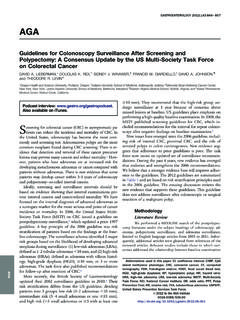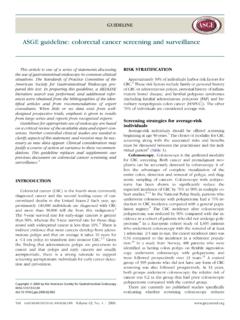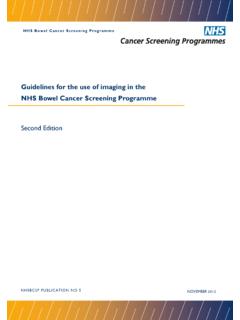Transcription of Review Early Detection of Colorectal Cancer …
1 Journal of Cancer 2014, Vol. 5 262 JJoouurrnnaall ooff CCaanncceerr 2014; 5(4): 262-271. doi: Review Early Detection of Colorectal Cancer recurrence in Patients Undergoing Surgery with Curative Intent: Current Status and Challenges Patrick. E. Young1,3, Craig M. Womeldorph2,3, Eric K. Johnson4, Justin A. Maykel5, Bjorn Brucher6, Alex Stojadinovic6, Itzhak Avital6, Aviram Nissan7, Scott R. Steele4 1. Department of Medicine, Division of Gastroenterology, Walter Reed National Military Medical Center, Bethesda, Maryland, USA 2.
2 Department of Medicine, Division of Gastroenterology, San Antonio Military Medical Center, San Antonio, TX, USA 3. Department of Medicine, Uniformed Services University of Health Science, Bethesda, MD, USA 4. Department of Surgery, Madigan Army Center, Tacoma, WA, USA 5. Division of Colorectal Surgery, University of Massachusetts Memorial Medical Center, Worcester, MA, USA 6. Bon Secours Cancer Institute, Richmond VA, USA 7. Department of Surgery, Hadassah-Hebrew University Medical Center, Jerusalem, Israel Corresponding author: Scott R.
3 Steele, MD, Madigan Army Medical Center, Department of Surgery, 9040a Fitzsimmons Dr., Tacoma, WA 98431. Phone: 253-968-2200; Fax: 253-968-0232; Email: Ivyspring International Publisher. This is an open-access article distributed under the terms of the Creative Commons License ( licenses/by-nc- ). Reproduction is permitted for personal, noncommercial use, provided that the article is in whole, unmodified, and properly cited. Published: Abstract Despite advances in neoadjuvant and adjuvant therapy, attention to proper surgical technique, and improved pathological staging for both the primary and metastatic lesions, almost half of all col-orectal Cancer patients will develop recurrent disease.
4 More concerning, this includes ~25% of patients with theoretically curable node-negative, non-metastatic Stage I and II disease. Given the annual incidence of Colorectal Cancer , approximately 150,000 new patients are candidates each year for follow-up surveillance. When combined with the greater population already enrolled in a surveillance protocol, this translates to a tremendous number of patients at risk for recurrence . It is therefore imperative that strategies aim for Detection of recurrence as Early as possible to allow initiation of treatment that may still result in cure.
5 Yet, controversy exists regarding the optimal surveillance strategy (high-intensity vs. traditional), ideal testing regimen, and overall effectiveness. While benefits may involve earlier Detection of recurrence , psychological welfare improvement, and greater overall survival, this must be weighed against the potential disadvantages including more invasive tests, higher rates of reoperation, and increased costs. In this Review , we will ex-amine the current options available and challenges surrounding Colorectal Cancer surveillance and Early Detection of recurrence .
6 Key words: Colorectal Cancer , colonoscopy, EUS, CEA, recurrence Introduction Colorectal Cancer affects nearly 150,000 patients in the United States annually and is the cause of al-most 50,000 deaths. (1) In those fortunate enough to be candidates for surgery with curative intent, ade-quate follow-up can detect Early recurrence , meta-chronous malignancy, and metastatic disease. Multi-ple specialty societies have published recommenda-tions regarding appropriate follow up of such patients (Table 1).
7 (2-7) While these guidelines agree on many key points, there remain areas of controversy. Given that ~30-50% of patients undergoing a curative resection will ultimately have recurrent dis- Ivyspring International Publisher Journal of Cancer 2014, Vol. 5 263 ease, optimizing the surveillance strategy is para-mount. (4) For such a strategy to be meaningful, however, several basic requirements must be met. First, the recurrence should be detectable in an asymptomatic phase.
8 Otherwise, the clinician could simply wait for symptoms to occur rather than em-barking on any surveillance strategy. Second, the de-tection of recurrent or metachronous disease should lead to effective treatment and a better clinical out-come than no surveillance. Historically, this has pri-marily meant additional operative intervention since surgery was the only curative option in most cases, with other modalities such as chemotherapy reserved for palliative care.
9 More recently, advances in mini-mally invasive techniques ( , chemoembolization, cryotherapy, radio frequency ablation) and highly targeted biologic agents have somewhat changed this paradigm. Nonetheless, the principle still applies that if the patient is unwilling to undergo further treat-ment or would not be a candidate for such, ongoing surveillance is unwarranted. One of the difficulties clinicians face in inter-preting the literature on this subject is the rapid evo-lution of technology.
10 For instance, the first random-ized clinical trial comparing an intensive surveillance regimen to standard follow up was published in 1995, with patient accrual occurring in the late 1980 s. (8) Computed tomography failed to improve Early Detection in this study, but a CT scan performed with a 2-slice scanner 25 years ago is not the same as one performed on a 128-slice machine today. Improve-ments in surgical technique and postoperative man-agement have increased the survival of those operat-ed on for recurrences, while advances in chemother-apy and biologic agents have allowed patients who would have previously had unresectable disease to become resectable.











